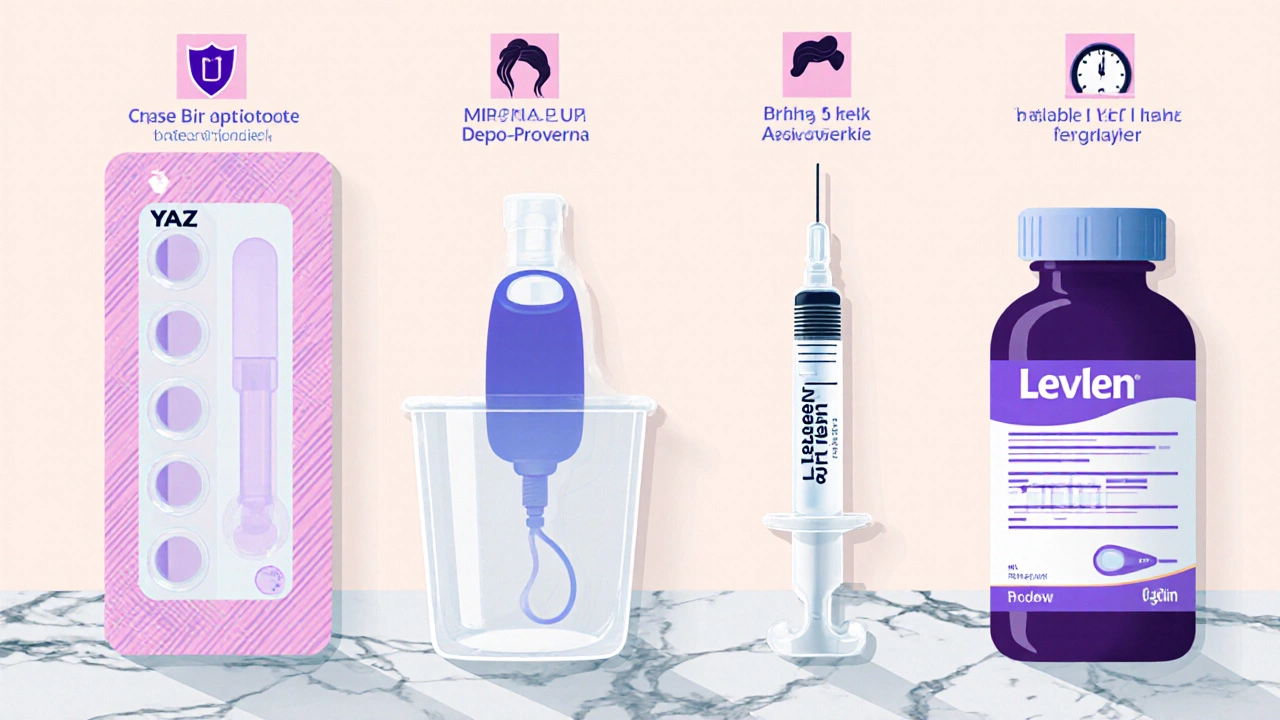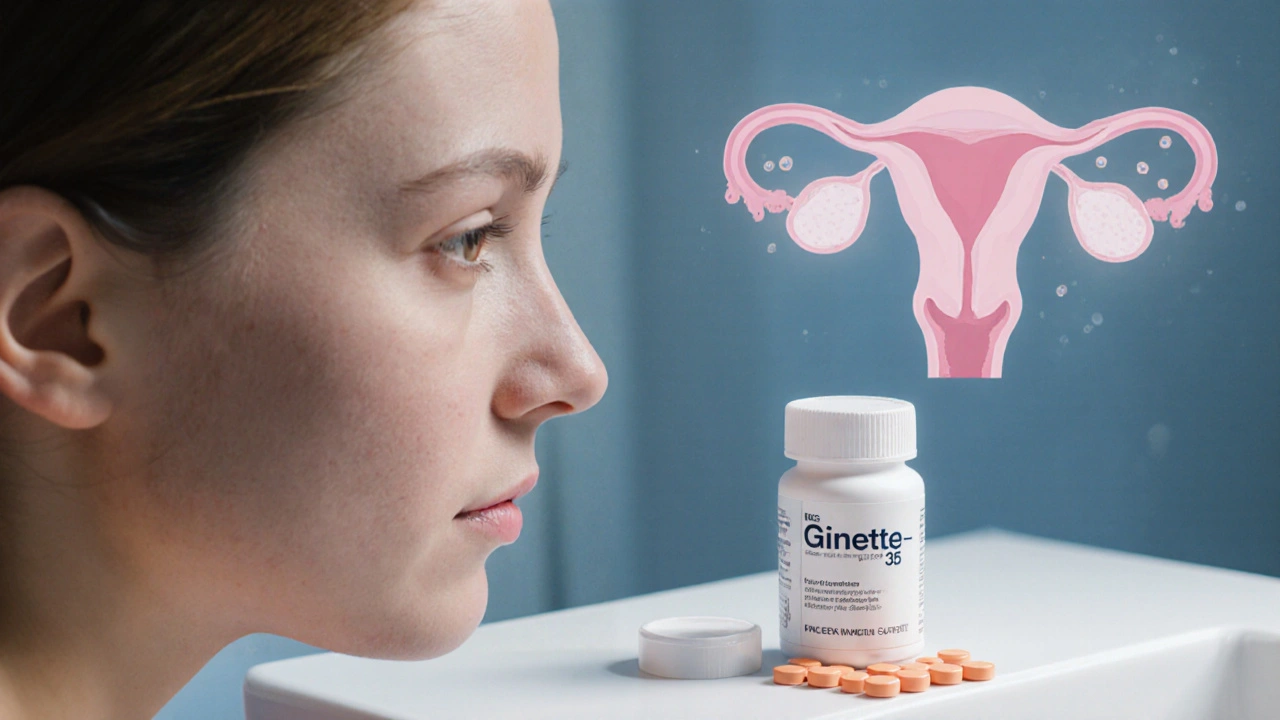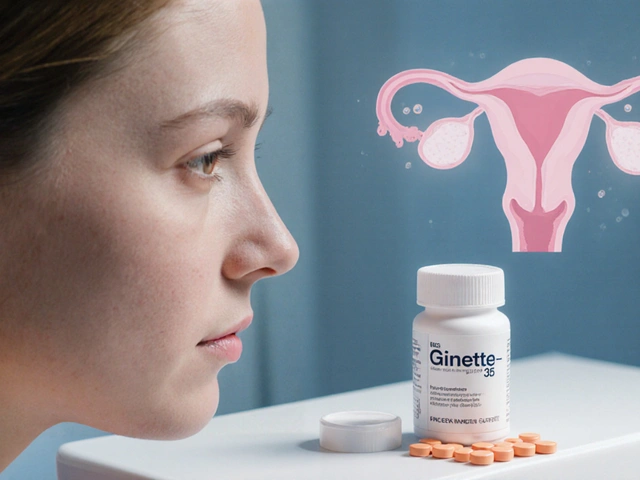Looking for a birth‑control pill that also tackles acne, PCOS or excess hair? Ginette-35 often pops up, but you might wonder if other options fit better. This guide breaks down Ginette‑35’s ingredients, how it works, and stacks it side‑by‑side with the most common alternatives so you can decide what matches your health goals.
Key Takeaways
- Ginette‑35 combines cyproterone acetate (anti‑androgen) with 35µg ethinyl estradiol, making it strong on acne and hirsutism.
- Alternatives vary by progestin type, estrogen dose, and extra benefits such as lower clot risk or longer dosing intervals.
- When choosing, weigh anti‑androgen need, cardiovascular risk, convenience, and any personal hormone sensitivities.
- For most women without severe androgen‑related issues, lower‑dose EE pills (e.g., levonorgestrel‑based) provide effective contraception with fewer side‑effects.
- Non‑oral options-like the Mirena IUD or the Depo‑Provera shot-eliminate daily pill fatigue but come with their own risk profiles.
What Is Ginette‑35?
Ginette-35 is a combined oral contraceptive that contains 35µg ethinyl estradiol (EE) plus 2mg cyproterone acetate (CPA). CPA is a synthetic progestin with strong anti‑androgen activity, so the pill is frequently prescribed for acne, polycystic ovary syndrome (PCOS) and hirsutism in addition to birth control.
Because the estrogen dose is relatively high compared with many modern low‑dose pills, Ginette‑35 may increase the risk of venous thromboembolism (VTE) in smokers or women over 35. It’s also contraindicated for anyone with a history of blood clots, liver disease, or certain hormone‑sensitive cancers.
How Does Ginette‑35 Work?
The EE component suppresses the pituitary release of follicle‑stimulating hormone (FSH) and luteinizing hormone (LH), preventing ovulation. CPA adds two effects: it acts as a progestogen to thicken cervical mucus (blocking sperm) and, more importantly, blocks androgen receptors, curbing the skin‑producing oil (sebum) that leads to acne.
These mechanisms mean Ginette‑35 treats both contraception and androgen‑related skin conditions in one pill, a convenience many patients appreciate.
Who Typically Uses Ginette‑35?
- Women aged 18‑35 seeking reliable contraception plus acne or hirsutism control.
- Patients diagnosed with PCOS who need hormonal regulation.
- Those who prefer a daily oral regimen over implants, IUDs or injections.
It’s less ideal for smokers over 35, women with a personal or family history of clotting disorders, or anyone directly sensitive to high estrogen levels.

Alternative Hormonal Contraceptives
Below are the most widely used alternatives, each with its own blend of progestin and estrogen (or no estrogen at all).
Diane-35 is essentially the same formulation as Ginette‑35-35µg EE + 2mg CPA-but marketed primarily for severe acne and PCOS in many countries. The safety profile mirrors Ginette‑35.
Yaz pairs 20µg EE with 3mg drospirenone, a progestin that has mild anti‑androgenic and anti‑mineralocorticoid effects, helping with acne and water retention while offering a lower estrogen dose.
Yasmin is virtually identical to Yaz (20µg EE + 3mg drospirenone) but marketed under a different brand name.
Levlen contains 30µg EE and 150µg levonorgestrel, a second‑generation progestin with no anti‑androgen effect. It’s a solid, low‑cost choice for contraception without extra skin benefits.
Ortho Tri‑Cyclen uses 35µg EE + 0.75mg norgestimate, a third‑generation progestin that offers mild anti‑androgenic activity and lower clot risk than CPA‑based pills.
Mirena IUD releases 20µg levonorgestrel per day locally in the uterus, providing up to five years of contraception while reducing menstrual bleeding. No systemic estrogen means virtually no VTE risk.
Depo‑Provera is a quarterly injection of 150mg medroxyprogesterone acetate. It’s estrogen‑free, so‑called “mini‑pill” style, but can cause weight gain and bone density loss with long‑term use.
Side‑by‑Side Comparison
| Brand | Estrogen (EE µg) | Progestin / Dose | Anti‑androgen? | Primary Indications | VTE Risk* | Typical Use |
|---|---|---|---|---|---|---|
| Ginette‑35 | 35 | Cyproterone acetate 2mg | Strong | Contraception, acne, PCOS | ↑ (high‑dose EE + CPA) | One pill daily |
| Diane‑35 | 35 | Cyproterone acetate 2mg | Strong | Severe acne, PCOS | ↑ (same as Ginette‑35) | One pill daily |
| Yaz / Yasmin | 20 | Drospirenone 3mg | Moderate | Contraception, acne, PMDD | Moderate (lower EE) | One pill daily |
| Levlen | 30 | Levonorgestrel 150µg | None | Contraception only | Low-moderate | One pill daily |
| Ortho Tri‑Cyclen | 35 | Norgestimate 0.75mg | Weak‑moderate | Contraception, acne | Low‑moderate | One pill daily |
| Mirena IUD | 0 (estrogen‑free) | Levonorgestrel 20µg/day | None | Long‑term contraception, heavy bleeding | Very low | Inserted by clinician, 5‑year life |
| Depo‑Provera | 0 (estrogen‑free) | Medroxyprogesterone acetate 150mg | None | Contraception, endometriosis | Low | Injection every 12weeks |
*VTE risk levels are based on pooled data from large cohort studies (e.g., WHO‑MUSE). Higher estrogen and potent progestins such as CPA increase clot risk, especially in smokers over 35.
Decision Criteria - What to Weigh Before Picking
- Anti‑androgen need: If acne or hirsutism is a priority, CPA (Ginette‑35/Diane‑35) or drospirenone (Yaz/Yasmin) are the only options with proven benefit.
- Estrogen exposure: Lower EE (20‑30µg) lowers VTE risk and may improve mood stability.
- Cardiovascular profile: Age, smoking status, personal clot history, and hypertension should push you toward low‑EE or estrogen‑free methods.
- Convenience: Daily pills require routine; IUDs and injections reduce daily burden but need clinician visits.
- Side‑effect tolerance: Some women experience weight gain, breast tenderness, or mood swings with higher estrogen; others dislike spotting that can happen with low‑dose pills.

Best‑For / Not‑For Quick Guide
- Best for severe acne/PCOS: Ginette‑35, Diane‑35, or Yaz/Yasmin.
- Best for low clot risk: Mirena IUD, low‑dose levonorgestrel pills (Levlen), or Depo‑Provera.
- Best for convenience: Monthly injection (Depo‑Provera) or 5‑year IUD (Mirena).
- Not for smokers >35: Any high‑dose EE pill, especially those with CPA.
- Not for women sensitive to progesterone‑related mood changes: Consider estrogen‑only patches or the hormonal IUD that releases locally.
Practical Tips & Common Pitfalls
- Always start Ginette‑35 on day 1 of your period or use a backup method for the first 7days.
- If you miss a pill, follow the specific “missed‑dose” chart on the package-usually take the missed pill ASAP, then continue with the rest.
- Check liver function annually if you stay on a high‑EE pill for more than a year.
- When switching from a CPA‑based pill to a lower‑dose version, give a 7‑day washout period to avoid hormonal overlap.
- For IUD candidates, schedule a pelvic exam first; some providers require a negative pregnancy test.
Frequently Asked Questions
Can Ginette‑35 be used for weight loss?
No. Ginette‑35’s main purpose is contraception and androgen control. Some users report water retention from the high estrogen, which can temporarily increase scale weight, but it does not promote fat loss.
Is it safe to take Ginette‑35 while breastfeeding?
Generally not recommended. The high estrogen dose can reduce milk supply, and CPA passes into breast milk. A progestin‑only method or the Mirena IUD is usually advised for nursing mothers.
How quickly does acne improve on Ginette‑35?
Most patients notice lighter lesions within 4‑6weeks, but full clearance can take 3‑6months, depending on severity and skin type.
Can I switch from Ginette‑35 to an IUD without a break?
Yes. Insert the IUD on the first day of your period or after a negative pregnancy test, then discard the remaining Ginette‑35 pills. No hormone‑free interval is needed.
What are the bleeding patterns for low‑dose vs. high‑dose pills?
High‑dose EE (35µg) like Ginette‑35 often leads to more consistent withdrawal bleeding, while low‑dose pills (20‑30µg) can cause spotting or lighter periods. The Mirena IUD usually reduces bleeding dramatically over the first few months.
Next Steps & Troubleshooting
If you’re leaning toward Ginette‑35 but have concerns about clot risk, schedule a quick blood pressure check and discuss smoking cessation with your GP. For acne‑only needs, try a drospirenone pill first; if results are lackluster, the CPA combo can be added under medical supervision.
Should you experience persistent headaches, breast tenderness, or leg swelling while on a high‑EE pill, stop immediately and seek medical advice-these can be early signs of VTE.
Finally, keep a personal health log: note start dates, any side‑effects, and menstrual changes. This record helps clinicians fine‑tune your contraception choice and quickly spot issues.




Kayla Charles
October 7, 2025 at 14:20When you’re scrolling through the sea of birth‑control options, it can feel overwhelming, but think of it like building a personalized toolkit for your health goals. Ginette‑35 shines when the anti‑androgenic punch is the priority, because cyproterone acetate directly blocks those pesky hormones that fuel acne and excess hair. At the same time, the 35 µg of ethinyl estradiol provides solid cycle control, which many people find reassuring. The flip side is that the higher estrogen dose nudges the clot risk upward, especially for smokers over 35, so a thorough risk assessment with your provider is essential. If you’ve never taken a progestin‑only method, the shift to a combo pill like this can also help normalize your menstrual flow, which is a boon for those with irregular cycles from PCOS. Another advantage is the convenience factor-one pill a day fits neatly into most routines without the need for clinic visits or device insertions. However, you should also weigh the potential side effects: breast tenderness, mood swings, and occasional spotting are reported by a subset of users. For many, the trade‑off of stronger acne control outweighs these minor nuisances, but staying vigilant for any signs of deep‑vein thrombosis is non‑negotiable. If you’re on a low‑dose levonorgestrel pill and still battling breakouts, stepping up to a CPA‑based formulation often yields noticeable improvement within six weeks. Remember to start the pack on the first day of your period or use backup contraception for the first seven days to avoid an unintended pregnancy. Annual labs, especially liver function tests, are a smart precaution if you stay on a high‑EE pill beyond a year. Lastly, keep an open line of communication with your healthcare team; many side effects can be mitigated by timing the pill start with your cycle or adjusting supplemental vitamins. In short, Ginette‑35 is a powerful tool for acne‑prone patients, but it demands a thoughtful approach to cardiovascular safety and personal tolerance.
Paul Hill II
October 9, 2025 at 08:00One practical tip is to align your pill schedule with a daily habit you already have, such as brushing your teeth, which can boost adherence without extra effort.
Stephanie Colony
October 11, 2025 at 01:40It’s bewildering how many people still cling to outdated notions that any high‑dose estrogen pill is automatically the best choice, disregarding the nuanced pharmacology that separates CPA from newer progestins.
Abigail Lynch
October 12, 2025 at 19:20Some claim the pharmaceutical industry pushes these combo pills to keep us dependent, yet they conveniently ignore that the same companies fund the research proving the anti‑androgenic benefits for severe acne.
David McClone
October 14, 2025 at 13:00Funny how the side‑effect profile reads like a menu of “what could go wrong” – but hey, at least you’ll have a clear list for your next doctor’s appointment.
Jessica Romero
October 16, 2025 at 06:40From a clinical standpoint, the cyproterone acetate dose in Ginette‑35 provides a robust anti‑androgenic effect, which is why dermatologists often co‑prescribe it for patients with hormonally driven acne. However, the trade‑off is the elevated estrogen exposure, which statistically correlates with a modest increase in venous thromboembolism risk, particularly in women who smoke or are over the age of 35. It’s crucial to individualize therapy: a thorough cardiovascular risk assessment should precede initiation, and alternative low‑dose estrogen formulations may be preferable for patients with a family history of clotting disorders. In terms of menstrual control, the 35 µg EE component tends to maintain a more predictable withdrawal bleed compared to ultra‑low dose pills, which can be advantageous for those who prefer regularity. That said, patients should be counseled on the possibility of breakthrough spotting, especially during the first few cycles as the endometrium stabilizes. If the primary goal is acne suppression and the patient has no contraindications, Ginette‑35 remains a solid first‑line option, but continuous monitoring and open dialogue with the prescribing clinician are essential for optimal outcomes.
Michele Radford
October 18, 2025 at 00:20Choosing a pill that knowingly raises clot risk while you’re a smoker is an irresponsible decision that reflects poorly on both patient and provider.
Mangal DUTT Sharma
October 19, 2025 at 18:00I totally get how confusing all these options can be, so let’s break it down together 😊
First, think about what matters most to you – is it acne control, low clot risk, or convenience?
If acne is the top priority, the CPA in Ginette‑35 is a powerhouse, but you’ll want to keep an eye on any signs of swelling or tenderness.
On the other hand, if you’re worried about blood clots, the Mirena IUD or a low‑dose levonorgestrel pill might give you peace of mind.
Don’t forget to schedule a quick check‑up to discuss your smoking status; quitting can dramatically lower any added risk from higher estrogen doses.
And remember, you don’t have to stick with one method forever – switching is always an option if your needs change.
Gracee Taylor
October 21, 2025 at 11:40It’s great to see everyone weighing the pros and cons, and I think the key takeaway is that personal health history should drive the final choice rather than brand hype.
Leslie Woods
October 23, 2025 at 05:20Honestly this guide is super helpful
Manish Singh
October 24, 2025 at 23:00I think the info is really usefull and it helps me tlook into my options better
Dipak Pawar
October 26, 2025 at 16:40From a pharmacoeconomic perspective, the cost‑effectiveness of a high‑dose CPA pill can be justified in populations where acne imposes a significant psychosocial burden, yet it is essential to factor in regional insurance formularies and patient out‑of‑pocket expenses. In many low‑ and middle‑income settings, the availability of generic equivalents for levonorgestrel‑based pills offers a more affordable alternative, though the anti‑androgenic efficacy may be insufficient for severe cases. Moreover, cultural attitudes toward menstrual suppression and hormonal interventions vary widely; for instance, certain communities may prioritize non‑oral routes, favoring IUDs or injectables, which can influence adherence patterns. Clinicians should therefore adopt a shared decision‑making model that incorporates both clinical evidence and sociocultural context, ensuring that the chosen contraceptive aligns with the patient’s values, lifestyle, and risk profile.
Jonathan Alvarenga
October 28, 2025 at 10:20The way some users glorify Ginette‑35 without acknowledging its clot risk is downright negligent. While the anti‑androgenic benefits are real, the literature repeatedly warns that the combination of 35 µg EE and cyproterone acetate spikes thrombotic events, especially in smokers and women over 35. Ignoring these warnings in favor of a quick acne fix betrays a superficial view of patient safety. Additionally, the marketing hype often glosses over the fact that lower‑dose estrogen pills can achieve comparable contraceptive efficacy with a markedly better safety profile. In short, any recommendation that downplays the vascular risks in favor of aesthetic outcomes is ethically questionable.
Jim McDermott
October 30, 2025 at 04:00I love how the guide lays out the side‑effect profiles clearly, making it easier to match a pill to my personal health checklist.
Naomi Ho
October 31, 2025 at 21:40Remember: always discuss any new contraceptive with your doctor first
Christine Watson
November 2, 2025 at 15:20Stay positive! With the right info, you’ll find a birth‑control option that fits both your health and lifestyle perfectly.